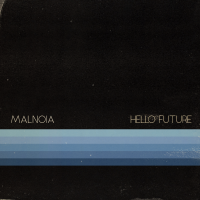In an ever-changing and increasingly digital world, it becomes more difficult to define what it is to be human, and the role and relevance of art are pondered. Pianist, composer, and bandleader Jorn Swart and his trio Malnoia tackle these questions head-on in their new album Hello Future. Through their original music, they draw on an eclectic pool of influences ranging from sci-fi film to philosophy, and pair their compositions with short fiction.
Hello Future is an artistic exploration of what it means to be human in a technological age, and of the value of art in such an age, utilizing the hybrid medium of short stories and music. This bold concept was not, however, born in a vacuum, but out of lengthy conversations, classic movies, and literature. “As a trio, we’ve had rehearsals devolve into long discussions about some of these issues,” Swart says. “[These discussions] planted the seed for an overall theme for the record.” Swart has become an avid reader of science fiction and has found himself drawn particularly to the works of Isaac Asimov, an author known for philosophically-laden short stories. Asimov’s writing led Swart to the idea of employing short stories to elaborate on the themes found within this music in a method Swart describes as “almost like reversed film scoring: the stories set the tone for the music, instead of vice-versa.” Swart wrote two stories himself and commissioned three authors to write the other eight. The final influence in the conceptual cocktail from which Hello Future was born is the iconic “Tears in Rain” monologue from the 1982 film Blade Runner. In this monologue, an artificial intelligence, shortly before he dies, reflects upon the beauty and wonder he experienced in his life. Both the monologue itself and the accompanying film score are admired by the members of Malnoia for their craftsmanship and the moment that is created by their combination. To capture the essence of all Hello Future entails, Swart and Malnoia are putting together an album launch experience, complete with interviews, making-of anecdotes, a live stream, and video narrations of each story.
The album’s title, Hello Future, has two distinct interpretations. The first is a realization that we have already arrived in the future – a technological world that is both welcoming and worrying. NYC poet George Wallace brings this idea to life in his poem for Tubifoot, evoking a character left behind by the march of time. The second is a perspective: looking towards a future still to come with both optimism and a healthy amount of caution. Swart acknowledges that while much of science fiction has a pessimistic view of this technological future, Hello Future does not feel hopeless. “It’s more like we’re asking questions, and asking people to think about some of this,” Swart tells. “We’re embracing the future that’s increasingly digital, but we’re playing a form of music that’s uniquely human: improvisations are like a little look inside a human’s brain.” Swart sees this as illustrated in the short story accompanying Prelude to Singularity, by writer Chloe Sarbib, in which a listener describes a concert that moved them like nothing ever has, only to later discover that the music was composed by an algorithm. While Swart admits this illustration is “pretty dark,” he also uses it to contemplate the nature of creativity and expression. “Part of this album tries to prove through the music that there’s something unique and beautiful about humans creating art.”
Part of the uniqueness of Hello Future comes from Malnoia’s distinctive instrumentation. While the use of the trio is common in both classical and jazz music, a trio comprised of piano, viola, and bass clarinet has almost certainly never been orchestrated prior to Malnoia. Inspired by composers such as Paul Hindemith, Claude Debussy, and Sergei Prokofiev from the classical realm and Duke Ellington, Thelonious Monk, and Keith Jarrett from jazz, Swart—the sole composer for Malnoia—capitalizes on the stark differences and vast combinations of tones, textures, and techniques found in Malnoia’s instrumentation. Practically, the lack of bass and drums allows the trio the rhythmic and melodic fluidity associated with chamber ensembles, regularly utilizing the ability to trade musical roles within a given piece. “For example,” Swart describes, “Benni (our violist) might be strumming, or playing rhythmic pizzicato patterns, providing a rhythmic backbone, [while] Lucas (bass clarinet) might be playing the bass part, but can easily switch to play the melody.” What is paramount to note is that while Malnoia draws on these chamber music elements, it still retains a strong lineage to the jazz tradition, through its use of improvisations, forms, sounds, and language.
Hello Future features ten original compositions by Swart, in addition to the track from the Blade Runner soundtrack. One such original is Paultjuh. This piece takes influence musically from Radiohead—particularly their Karma Police—with its rhythmically ambiguous piano opening that obscures the downbeat and was composed for Swart’s best friend on his 30th birthday. Paultjuh works in tandem with a short story written for the album by Leah Sarbib about a robot who awakes after a long time in standby to find the world overgrown, in disrepair, and filled with small mammals. “Even though it might sound post-apocalyptic I think it’s quite a sweet story,” Swart tells. The opening track on Hello Future is an original by Swart entitled “First Ocean" that ties in with a short story he wrote. The story follows a traveler whose job is to terraform planets, yet who has been at it for so long that he has forgotten the smell, feel, and sensation of the ocean. When he finally gets to visit one of the planets he’s terraformed, he gets to smell the ocean for what seems like the first time. Musically, this piece utilizes impressionistic elements to evoke images with lower ostinatos beneath gently floating melodies, and features both a bass clarinet and piano solo to capture the concepts at play.
The vivacity and emotive life brought to Malnoia’s music is due not only to Swart’s masterful compositions, but also to the brilliance of its members. Benni von Gutzeit, the jazz violist most known for his work with the GRAMMY-winning Turtle Island String Quartet, contributes not only his vast skill as an improviser, but his versatility to the band. Utilizing a bow technique known as “chopping,” Benni is able to add percussive and rhythmic elements, much as a bebop drummer may accompany a group. Lucas Pino, best known as the bandleader and tenor saxophonist for his No Net Nonet, contributes here on his robust and flexible voice of the bass clarinet. Swart cites Pino’s experience as a bandleader/composer as invaluable, allowing him to add an element of orchestration to how he executes both what is predetermined and what is improvised, artfully swapping between the foundational role of a bass and the soaring melodicism he is well known for.
In Hello Future, Jorn Swart and Malnoia boldly go where few artists have dared venture. By blurring the lines between philosophy, music, literature, and storytelling, Malnoia has created an all-encompassing album concept that not only shoots for the stars, but also helps us imagine what it will be like when we reach them. Swart and Malnoia ponder the complex questions about art, AI, and humanity- and posit answers, angles of thought, and more questions to help listeners scratch beyond the surface of this concept. Where Asimov proposed the laws of robotics in his vision of a technological future, Swart greets a future where the laws of art straddle the line between human and artificial, and yet lose none of their wonder. With Hello Future, Malnoia establishes itself as a name to know not merely in the halls of music, but in the halls of creativity itself.
Hello Future releases on Outside in Music on March 19th, 2021.
Hello Future is an artistic exploration of what it means to be human in a technological age, and of the value of art in such an age, utilizing the hybrid medium of short stories and music. This bold concept was not, however, born in a vacuum, but out of lengthy conversations, classic movies, and literature. “As a trio, we’ve had rehearsals devolve into long discussions about some of these issues,” Swart says. “[These discussions] planted the seed for an overall theme for the record.” Swart has become an avid reader of science fiction and has found himself drawn particularly to the works of Isaac Asimov, an author known for philosophically-laden short stories. Asimov’s writing led Swart to the idea of employing short stories to elaborate on the themes found within this music in a method Swart describes as “almost like reversed film scoring: the stories set the tone for the music, instead of vice-versa.” Swart wrote two stories himself and commissioned three authors to write the other eight. The final influence in the conceptual cocktail from which Hello Future was born is the iconic “Tears in Rain” monologue from the 1982 film Blade Runner. In this monologue, an artificial intelligence, shortly before he dies, reflects upon the beauty and wonder he experienced in his life. Both the monologue itself and the accompanying film score are admired by the members of Malnoia for their craftsmanship and the moment that is created by their combination. To capture the essence of all Hello Future entails, Swart and Malnoia are putting together an album launch experience, complete with interviews, making-of anecdotes, a live stream, and video narrations of each story.
The album’s title, Hello Future, has two distinct interpretations. The first is a realization that we have already arrived in the future – a technological world that is both welcoming and worrying. NYC poet George Wallace brings this idea to life in his poem for Tubifoot, evoking a character left behind by the march of time. The second is a perspective: looking towards a future still to come with both optimism and a healthy amount of caution. Swart acknowledges that while much of science fiction has a pessimistic view of this technological future, Hello Future does not feel hopeless. “It’s more like we’re asking questions, and asking people to think about some of this,” Swart tells. “We’re embracing the future that’s increasingly digital, but we’re playing a form of music that’s uniquely human: improvisations are like a little look inside a human’s brain.” Swart sees this as illustrated in the short story accompanying Prelude to Singularity, by writer Chloe Sarbib, in which a listener describes a concert that moved them like nothing ever has, only to later discover that the music was composed by an algorithm. While Swart admits this illustration is “pretty dark,” he also uses it to contemplate the nature of creativity and expression. “Part of this album tries to prove through the music that there’s something unique and beautiful about humans creating art.”
Part of the uniqueness of Hello Future comes from Malnoia’s distinctive instrumentation. While the use of the trio is common in both classical and jazz music, a trio comprised of piano, viola, and bass clarinet has almost certainly never been orchestrated prior to Malnoia. Inspired by composers such as Paul Hindemith, Claude Debussy, and Sergei Prokofiev from the classical realm and Duke Ellington, Thelonious Monk, and Keith Jarrett from jazz, Swart—the sole composer for Malnoia—capitalizes on the stark differences and vast combinations of tones, textures, and techniques found in Malnoia’s instrumentation. Practically, the lack of bass and drums allows the trio the rhythmic and melodic fluidity associated with chamber ensembles, regularly utilizing the ability to trade musical roles within a given piece. “For example,” Swart describes, “Benni (our violist) might be strumming, or playing rhythmic pizzicato patterns, providing a rhythmic backbone, [while] Lucas (bass clarinet) might be playing the bass part, but can easily switch to play the melody.” What is paramount to note is that while Malnoia draws on these chamber music elements, it still retains a strong lineage to the jazz tradition, through its use of improvisations, forms, sounds, and language.
Hello Future features ten original compositions by Swart, in addition to the track from the Blade Runner soundtrack. One such original is Paultjuh. This piece takes influence musically from Radiohead—particularly their Karma Police—with its rhythmically ambiguous piano opening that obscures the downbeat and was composed for Swart’s best friend on his 30th birthday. Paultjuh works in tandem with a short story written for the album by Leah Sarbib about a robot who awakes after a long time in standby to find the world overgrown, in disrepair, and filled with small mammals. “Even though it might sound post-apocalyptic I think it’s quite a sweet story,” Swart tells. The opening track on Hello Future is an original by Swart entitled “First Ocean" that ties in with a short story he wrote. The story follows a traveler whose job is to terraform planets, yet who has been at it for so long that he has forgotten the smell, feel, and sensation of the ocean. When he finally gets to visit one of the planets he’s terraformed, he gets to smell the ocean for what seems like the first time. Musically, this piece utilizes impressionistic elements to evoke images with lower ostinatos beneath gently floating melodies, and features both a bass clarinet and piano solo to capture the concepts at play.
The vivacity and emotive life brought to Malnoia’s music is due not only to Swart’s masterful compositions, but also to the brilliance of its members. Benni von Gutzeit, the jazz violist most known for his work with the GRAMMY-winning Turtle Island String Quartet, contributes not only his vast skill as an improviser, but his versatility to the band. Utilizing a bow technique known as “chopping,” Benni is able to add percussive and rhythmic elements, much as a bebop drummer may accompany a group. Lucas Pino, best known as the bandleader and tenor saxophonist for his No Net Nonet, contributes here on his robust and flexible voice of the bass clarinet. Swart cites Pino’s experience as a bandleader/composer as invaluable, allowing him to add an element of orchestration to how he executes both what is predetermined and what is improvised, artfully swapping between the foundational role of a bass and the soaring melodicism he is well known for.
In Hello Future, Jorn Swart and Malnoia boldly go where few artists have dared venture. By blurring the lines between philosophy, music, literature, and storytelling, Malnoia has created an all-encompassing album concept that not only shoots for the stars, but also helps us imagine what it will be like when we reach them. Swart and Malnoia ponder the complex questions about art, AI, and humanity- and posit answers, angles of thought, and more questions to help listeners scratch beyond the surface of this concept. Where Asimov proposed the laws of robotics in his vision of a technological future, Swart greets a future where the laws of art straddle the line between human and artificial, and yet lose none of their wonder. With Hello Future, Malnoia establishes itself as a name to know not merely in the halls of music, but in the halls of creativity itself.
Hello Future releases on Outside in Music on March 19th, 2021.
































